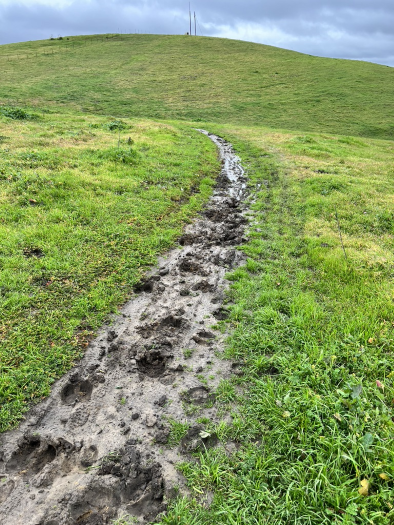By Scott Bartlebaugh, BTCEB Advocacy Director

Cattle grazing and Crockett Hills Regional Park is a story of the the good, bad, and the ugly. In an ideal world we have normal rainfall every year and plenty of places to put cattle during the wet season that doesn’t involve trail damage. Ok in an IDEAL world we don’t have to deal with cattle at all and we have more trails to ride than we know what to do with. But we live in this real world of ours.
The cattle are there primarily to manage wildfire fuel loads and additionally to reduce impact of invasive vegetation species. Managing fuel loads is a high priority for the park district, the general public, important to the surrounding residents (disclaimer: I’m one of them) and awareness of fire risk is high these days. Cattle grazing is the cheapest option for grassland fuel management. It’s also the highest impact option on the trails.
Rotation of the cattle to different pastures at different times of the year can reduce the damage to trails. Unfortunately the grazing infrastructure is less than robust enough to provide good grazing pasture options through repeated drought years. Water supply via rain supplied ponds, solar powered pumped wells, and fencing are key infrastructure items. There are 4 pastures at Crockett Hills, the top (Soaring Eagle trail), the middle (Sugar City, Tree Frog, Goldfinch trails), the front (south of Goldfinch with just fire roads), and the Stewart property (land bank, no access to the east of top, middle and front pastures). There is no grazing north of the Cummings Skyway tunnel.
Amongst the ‘good’ is the local park supervisor who works with us to try to minimize the cattle damage and during the past two annual cycles the cattle were kept out of the middle and top pastures for the vast majority of what is normally the wet season and trail damage was minimal. Below normal rain made that easier to accomplish. Two seasons ago a rainless February and not much rain after that left the ponds in the top pasture empty when it was time for the cattle. Empty ponds resulted in the top pasture getting just about 1 week of grazing compared to the bulk of the summer months putting more load on the middle and front pastures. Good for trails but not so good for fuels management with the top pasture being under grazed and the front pasture overgrazed. Last season turned out to be another dry season and the front pasture didn’t recover. The top pasture was grazed but required water to be trucked in to the pair of poly tanks installed at the top of Sugar City. The top pasture catches up on fuels load but cattle are congregated right on top of the trail. Free probiotics for everyone! And now in the current season the front pasture wasn’t ready for grazing at the start of the rains and the Stewart property could only handle part of the herd which had already been reduced during the past 2 years of drought. This left a portion of the herd in the middle pasture. Above normal rain and cattle in the middle pasture give us an ugly scenario for trails.
So while there’s a bunch of trail ugly going on, there is more good. A number of water supply improvements are happening. Over the past season a water line was run to the middle pasture from the well on the Stewart property. A well should be drilled in the next few months to supply the top pasture. Permitting is ongoing to clean out the ponds in the top pasture and return them to their full water holding capacity. Side note – the sediment in the ponds also creates muck that cows sometimes get stuck in and die in addition to reducing rain water storage capacity. The park supervisor has also acquired some additional trail equipment (a Toro Dingo) and should be able to help out with remediation of cattle damage more easily. The EBRPD Small Trails Crew is getting a small Sweco grader in early 2022 and is slated to do some trail rehab at Crockett Hills. There’s also a 2nd tunnel under Cummings Skyway that leads to additional land banked property that may be an option for wet season grazing to protect trail conditions. And there’s a new grazer for Crockett Hills that is interested in finding ways to help reduce cattle impact on the trails and help support the mountain biking community. He’s been very impressed with the courtesy shown to his crew when they are out working the cattle. It’s the best and safest he’s ever seen – please keep up the good behavior folks. He may even be interested in some help when it’s time to move cattle between pastures.
There are a number of good things going on and it is getting better albeit slowly. Seeing the trails trampled after money is spent to install trails, and hundreds of volunteer hours are put in to maintain them boggles the mind. There are too many times when the hills are not filled with the sound of music . . . Managing fuel load and trail quality is difficult with the current resources but folks closest to it are doing what they can and it is getting better. If that isn’t good enough consider a discussion with your park district elected director to let them know how important this is to you.



